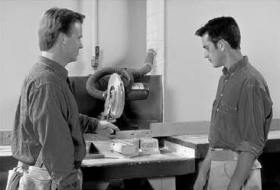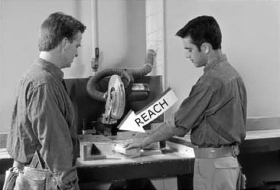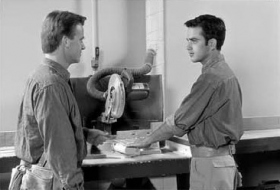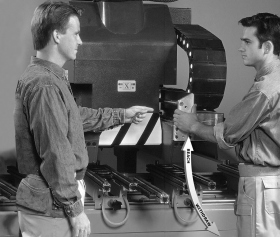With an understanding of confusion and the need for good control to bring order, one can easily observe workers and executives who breed confusions with bad control. There is a very simple but extremely powerful method to get a person familiarized and in communication with things so that he can be more in control of them. This is called Reach and Withdraw.
One would not expect a person to have much control or understanding of or skill in something with which he was not familiar. The
A person is out of communication with something because he is withdrawing from it and is not about to reach out to or contact any part of it.
If a person cannot reach and withdraw from a thing, he will be the effect of that thing.
If a person can reach for something and withdraw from it, he could be said to be in communication with that thing.
To be in communication with something is to be in a more causative position in relation to it.
By REACH we mean touching or taking hold of. It is defined as “to get to,” “come to” and/or “arrive at.”
By WITHDRAW we mean “move back from, let go.”
The Reach and Withdraw procedure brings a person into communication with and into a more causative position in relation to objects, people, spaces, boundaries and situations.
In the physical universe, communication with objects, forms, spaces and boundaries is best established by actual physical contact.
Reach and Withdraw is a valuable tool to use to get a person into good communication with his work environment, especially the tools and objects he uses.
A pilot would do Reach and Withdraw on all the objects and spaces of his airplane, his hangar, the earth; a secretary would do Reach and Withdraw on her typewriter, her chair, walls, spaces, her desk, etc.
Feeling comfortable with the tools of one’s trade is a very important step in getting out products. One can increase the amount of production tremendously with this action.
For example, a
Procedure
Reach and Withdraw procedure is easily learned. It can be done on any object or area. It can be done on an individual’s job environment, on a new piece of equipment, a machine, anything. It is done until the person is in good communication with his general environment or specific area being addressed.
1. Take the person to the area where you will be doing Reach and Withdraw. Explain to him you are going to do Reach and Withdraw and explain the procedure.
2. Tell him the commands to be used and ensure he understands these. The commands are:
A. “Reach that _________.” (naming and pointing to an object or person or area)
B. “Withdraw from that _________.” (naming and pointing to the same object or person or area)
A thing or part of something (e.g., “the big red button on the front of the machine”) or a space or a person is named in the blank.
3. Give him the first command. For example, “Reach that big red button on the front of the machine.”
Always point to the object (or person, space, etc.) each time you give a command so there will be no mistake made by the person doing it.
4. When the person has carried out the command,
5. Now give the second command, “Withdraw from that big red button on the front of the machine.” Acknowledge him when he has done so.
6. Continue to alternate the commands A, B, A, B and so on, with an
7. Reach and withdraw from that one thing, space or person until the individual either has a minor
8. Next, another object, space or person is chosen and the commands are taken to a win on that item.
Don’t keep the person reaching and withdrawing endlessly from the same part of anything that is being used, but go to different points and parts of an object being touched.
Walk around with the person doing the action, ensuring that he actually does get in physical contact with the points or areas of objects, spaces or people.
Choose objects in such a way as to progress from smaller objects to the larger objects available, touching different parts of each one in turn, to a minor win of some sort on that object or three sets of commands with no change. Also include walls and floors and other parts of the environment in doing this procedure.
When doing the action on a space or a room rather than an object, have the person walk into the room and walk out of the room over and over.
9. Continue until the person has a major win or a good realization and is very happy about the whole area being addressed. A major win would be a large improvement for the person such as a new awareness of his work area or a certainty about his job. Reach and Withdraw would not be continued past such a point.
Reach and Withdraw on the objects, people, situations, spaces and boundaries of a person’s job will greatly assist his control, familiarity and understanding of it.
the central or most important point or theme of something.
a medical officer in the armed services who is trained in aviation medicine.
a unit in the air force which usually consists of twelve to twenty-four aircraft.
give (someone) an acknowledgment. See also acknowledgment.
something said or done to inform another that his statement or action has been noted, understood and received.
the accomplishment of any desired improvement. Examples of wins would be a person increasing his ability to communicate, experiencing an increased feeling of well-being or gaining more certainty about some area of his life.






